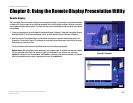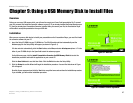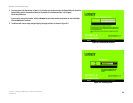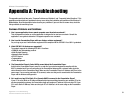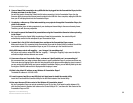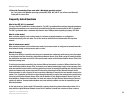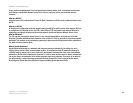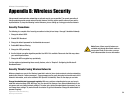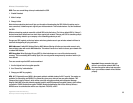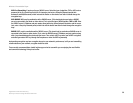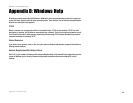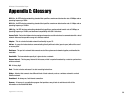
33
Appendix A: Troubleshooting
Frequently Asked Questions
Wireless-G Presentation Player
15.Does the Presentation Player work with a Macintosh operating system?
No, it only works with Windows operating systems 98SE,2000, Me, and XP. You will also need Microsoft
Powerpoint to convert files.
Frequently Asked Questions
What is the IEEE 802.11g standard?
It is one of the IEEE standards for wireless networks. The 802.11g standard allows wireless networking hardware
from different manufacturers to communicate, provided that the hardware complies with the 802.11g standard.
The 802.11g standard states a maximum data transfer rate of 54Mbps and an operating frequency of 2.4GHz.
What is ad-hoc mode?
When a wireless network is set to ad-hoc mode, the wireless-equipped computers are configured to
communicate directly with each other. The ad-hoc wireless network will not communicate with any wired
network.
What is infrastructure mode?
When a wireless network is set to infrastructure mode, the wireless network is configured to communicate with a
wired network through a wireless access point or router.
What is Roaming?
Roaming is the ability of a portable computer user to communicate continuously while moving freely throughout
an area greater than that covered by a single Wireless Network Access Point. Before using the roaming function,
the workstation must make sure that it is the same channel number as the Wireless Network Access Point of the
dedicated coverage area.
To achieve true seamless connectivity, the wireless LAN must incorporate a number of different functions. Each
node and Wireless Network Access Point, for example, must always acknowledge receipt of each message. Each
node must maintain contact with the wireless network even when not actually transmitting data. Achieving these
functions simultaneously requires a dynamic RF networking technology that links Wireless Network Access
Points and nodes. In such a system, the user’s end node undertakes a search for the best possible access to the
system. First, it evaluates such factors as signal strength and quality, as well as the message load currently being
carried by each Wireless Network Access Point and the distance of each Wireless Network Access Point to the
wired backbone. Based on that information, the node next selects the right Wireless Network Access Point and
registers its address. Communications between end node and host computer can then be transmitted up and
down the backbone.
As the user moves on, the end node’s RF transmitter regularly checks the system to determine whether it is in
touch with the original Wireless Network Access Point or whether it should seek a new one. When a node no



